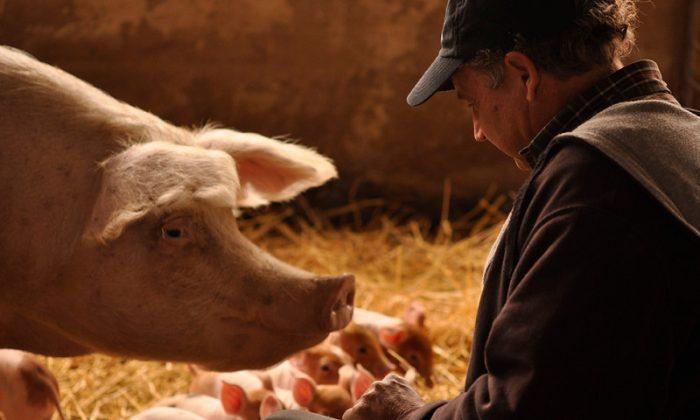Russ Kremer has an award winning passion for hog farming. People who visit his Missouri farm often remark that his humanely raised, drug-free animals are the happiest pigs they’ve ever seen.
According to Kremer, happy pigs means “marvelous meat.”
“I passionately believe that the way I raise hogs is the right way to raise hogs,” he said in a phone interview. “What’s of paramount importance is to treat the meat with tender loving care.”
A fifth generation pig farmer, Kremer, age 55, won the 2013 Natural Resources Defense Council’s (NRDC) Growing Green Food Producer award for his pioneering efforts toward more sustainable meat production.
Kremer’s Ozark Mountain Pork Cooperative consists of 52 family farms and sells to companies such as Whole Foods, Chipotle, and Costco. Chefs show their appreciation for the high quality pork by featuring farmers’ stories on their menus.
Kremer credits his success to building solid relationships that benefit everybody. In his food system, animals are better treated, farmers earn a better living, and consumers get a premium product they are proud to support.
“I truly believe that for a small- to moderate-sized farmer this authentic relationship marketing is our only hope,” he said. “It gives us a very loyal following, and it’s a win-win situation for everyone in the value chain.”
Breaking Away
Kramer’s farming style represents a small portion of the U.S. pork market, but his success challenges 60 years of conventional dogma. He only raises a fraction of the herd he once did, but Kremer says his old fashioned farming model proves just as efficient as and more lucrative than the factory system he left behind.
“We were spending about $16,000 per year on antibiotics and vets,” he said. “But the year that I went the new route, I eliminated that. You really save a lot of money on my method.”
As a young man just out of agriculture college, Kremer eagerly embraced the modern industry standard. Yet for all the profit and control the system promised, he soon found many flaws.
Animals raised in cages, crammed in warehouses, and fed a steady diet of growth promoting antibiotics allowed for more production, but the pigs lived a miserable existence, resulting in a greater percentage of death and disease, and according to Kremer, meat that didn’t taste as good.
The final insult was an injury that almost killed him. In the spring of 1989, a Yorkshire boar gored Kremer’s kneecap. His wound became so infected that his leg nearly doubled in size. Doctors gave him one antibiotic after another, but nothing seemed to work.
After a two-month, near-death struggle, a strong drug finally defeated the infection. The experience convinced Kremer that modern farming methods were to blame.
Rise of the Superbugs
Kremer’s exposure to antibiotic resistant bacteria is what some might call an occupational hazard—American meat processing workers often carry higher levels of “superbugs” on their clothes and bodies than the general public, according to the Natural Resources Defense Council (NRDC), and critics point to the enormous number of antibiotics used in U.S. factory farming for the cause.
According to the NRDC, 80 percent of the nation’s antibiotic supply is used in meat production, and most don’t treat illness. Instead, the drugs mostly serve either to promote growth or as a preventative against diseases associated with the crowded, unsanitary conditions of industrial meat production.
Superbugs are making their way off the farm in greater numbers. A recent Environmental Working Group (EWG) analysis of government data found that—from beef to chicken—much of the U.S. meat supply is tainted with antibiotic resistant bacteria. Experts warn that the trend poses a great risk to public health.
Many of the top medical and public health groups—including the American Medical Association (AMA), and the World Health Organization (WHO)—say that misuse of antibiotics has led to widespread bacterial resistance, where important medicines the public depends on are no longer effective.
“Things as common as strep throat or a child’s scratched knee could once again kill,” said Margaret Chan, WHO director general in a Copenhagen conference for infectious disease experts last year. “A post-antibiotic era means, in effect, an end to modern medicine as we know it.”
The U.S. Food and Drug Administration (FDA) proposed a ban on farms using penicillin and tetracycline for nontherapeutic purposes in 1977, but after years of congressional stalling, low-dose drugging of livestock remained the industry standard. Today, the FDA can’t even seem to get a voluntary withdrawal measure off the ground.
“It’s just astounding that this continues to happen and that we haven’t made more progress in stopping the usage,” said NRDC lawyer, Avinish Kar. “Really, the FDA has fallen down on protecting the public health on this issue.”
Regulators in Europe, meanwhile, have addressed the problem more directly. While American industries resistant to change argue that cutting back on antibiotics will ruin the meat market, examples overseas show that even in a factory setting producers can achieve drug-free success.
“There’s a fear that if antibiotics are taken away it will be a huge cost to the industry,” Kremer said. “I contend that there are enough alternatives that produce the same results.”
Wisdom of the Old Timers
Many European countries stopped using penicillin, tetracycline, and other antibiotic growth promoters by the mid-1970s, and the EU has since made even tighter restrictions. Denmark boasts the region’s strictest requirements on animal antibiotics, yet remains one of the world’s largest pork producers.
“If Europe can do it, and they’ve managed to do it without any significant effect on prices or production, I think we can do it too,” Kar said.
When Kremer visited Europe in 1999, he brought some drug-free farming methods back to the states. His research helped him develop a new feed mixture—whole oats, flax, and probiotics—that naturally made for healthier animals. When his pigs develop the sniffles, he adds oregano.
According to Kremer, while this knowledge is new for today’s farmers, it is merely a rediscovery of farming techniques used in his grandfather’s generation.
“The old timers had to learn how to be smart and work in harmony with nature. They were husbandry people and good stewards of the land,” he said. “They kind of had it figured out, but once pig farming became more industrialized we took a lot of those practices away, and put more of our emphasis on feeding commercial interests.”





